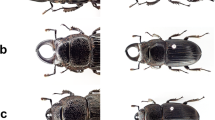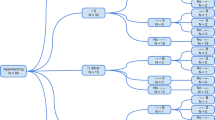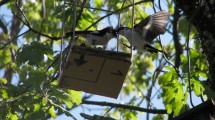Abstract
Interactions between male stag beetles usually involve aggressive behavior using their long mandibles as weapons to compete with rival males over females. Considerable variation exists within populations in male body size, and may affect their behavior and the outcome of male-male contests. We investigated the aggressive interactions between male Aegus chelifer chelifer, a small tropical stag beetle species. Morphological traits in relation to aggressiveness and the outcome of fights were examined in laboratory-reared beetles. The fight-engagement ratios of major and minor morph males were not significantly different and analyses revealed that the size of body parts had more effect on the fighting success than the weapon part (mandibles). The probability of winning a contest was higher in males with a larger head width (HW), and so HW was considered as the resource holding potential (RHP). No effects of the trait size on the initiation of fights or aggressive intensity was found. Relationships between the fight duration and RHP were not significantly consistent with any assessment strategies, but were close to the mutual assessment model.





Similar content being viewed by others
References
Arnott G, Elwood RW (2009) Assessment of fighting ability in animal contests. Anim Behav 77:991–1004
Bridge AP, Elwood RW, Dick JTA (2000) Imperfect assessment and limited information preclude optimal strategies in male–male fights in the orb-weaving spider Metellina mengei. Proc R Soc Lond B Biol Sci 267:273–279
Briffa M (2008) Decisions during fights in the house cricket, Acheta domesticus: mutual or self assessment of energy, weapons and size? Anim Behav 75:1053–1062
Briffa M (2014) What determines the duration of war? Insights from assessment strategies in animal contests. PLoS One 9:e108491
Briffa M, Elwood RW (2009) Difficulties remain in distinguishing between mutual and self-assessment in animal contests. Anim Behav 77:759–762
Cook JM, Bean D (2006) Cryptic male dimorphism and fighting in a fig wasp. Anim Behav 71:1095–1101
Ek-Amnuay P (2008) Beetles of Thailand. In: 2 edn. Amarin Printing and Publishing Public, Bangkok
Emlen DJ (1997) Alternative reproductive tactics and male-dimorphism in the horned beetle Onthophagus acuminatus (Coleoptera: Scarabaeidae). Behav Ecol Sociobiol 41:335–341
Goyens J, Dirckx J, Aerts P (2015a) Costly sexual dimorphism in Cyclommatus metallifer stag beetles. Funct Ecol 29:35–43
Goyens J, Dirckx J, Aerts P (2015b) Stag beetle battle behavior and its associated anatomical adaptations. J Insect Behav 28:227–244
Hardy IC, Field SA (1998) Logistic analysis of animal contests. Anim Behav 56:787–792
Hoem SA, Melis C, Linnell JD, Andersen R (2007) Fighting behaviour in territorial male roe deer Capreolus capreolus: the effects of antler size and residence. Eur J Wildl Res 53:1–8
Hofmann HA, Schildberger K (2001) Assessment of strength and willingness to fight during aggressive encounters in crickets. Anim Behav 62:337–348
Hongo Y (2014) Interspecific relationship between the Japanese horned beetle and two Japanese stag beetle species. Entomol Sci 17:134–137
Hongo Y, Okamoto K (2013) Interspecific contests between males of two Japanese stag beetle species, Lucanus maculifemoratus and Prosopocoilus inclinatus: what overcomes a body size disadvantage? Behaviour 150:39–59
Inoue A, Hasegawa E (2013) Effect of morph types, body size and prior residence on food-site holding by males of the male-dimorphic stag beetle Prosopocoilus inclinatus (Coleoptera: Lucanidae). J Ethol 31:55–60
Jennings DJ, Gammell MP, Carlin CM, Hayden TJ (2004) Effect of body weight, antler length, resource value and experience on fight duration and intensity in fallow deer. Anim Behav 68:213–221
Karino K, Niiyama H, Chiba M (2005) Horn length is the determining factor in the outcomes of escalated fights among male Japanese horned beetles, Allomyrina dichotoma L.(Coleoptera: Scarabaeidae). J Insect Behav 18:805–815
Kijimoto T, Pespeni M, Beckers O, Moczek AP (2013) Beetle horns and horned beetles: emerging models in developmental evolution and ecology. Wiley Interdiscip Rev Dev Biol 2:405–418
Kotiaho JS, Tomkins JL (2001) The discrimination of alternative male morphologies. Behav Ecol 12:553–557
Ligon JD, Thornhill R, Zuk M, Johnson K (1990) Male-male competition, ornamentation and the role of testosterone in sexual selection in red jungle fowl. Anim Behav 40:367–373
Mizunuma T, Nagai S (1994) Sekai no Kuwagatamushi Daizukan: the Lucanid beetles of the world. Mushisha, Tokyo
Okada Y, Suzaki Y, Miyatake T, Okada K (2012) Effect of weapon-supportive traits on fighting success in armed insects. Anim Behav 83:1001–1006
Payne RJH, Pagel M (1997) Why do animals repeat displays? Anim Behav 54:109–119
Pinratana A, Maes J-M (2003) Lucanidae of Thailand. Sunprinting, Bangkok
Pomfret JC, Knell RJ (2006) Sexual selection and horn allometry in the dung beetle Euoniticellus intermedius. Anim Behav 71:567–576
Pratt AE, McLain DK, Lathrop GR (2003) The assessment game in sand fiddler crab contests for breeding burrows. Anim Behav 65:945–955
Quinn GP, Keough MJ (2002) Experimental design and data analysis for biologists. Cambridge University Press, New York
R Development Core Team (2016) R: A Language and Environment for Statistical Computing
Rohlf FJ (2013) tpsDIG version 2.17. Department of Ecology and Evolution, State University of New York at Stony Brook, New York
Shiokawa T, Iwahashi O (2000a) Mandible dimorphism in males of a stag beetle, Prosopocoilus dissimilis okinawanus (Coleoptera: Lucanidae). Appl Entomol Zool 35:487–494
Shiokawa T, Iwahashi O (2000b) Mating success of small sized males of Japanese stag beetle Prosopocoilus dissimilis okinawanus Nomura. Jap J Entomol (New Ser) 3:157–165
Siva-Jothy MT (1987) Mate securing tactics and the cost of fighting in the Japanese horned beetle, Allomyrina dichotoma L.(Scarabaeidae). J Ethol 5:165–172
Small J, Cotton S, Fowler K, Pomiankowski A (2009) Male eyespan and resource ownership affect contest outcome in the stalk-eyed fly, Teleopsis dalmanni. Anim Behav 78:1213–1220
Smith JM (1982) Evolution and the theory of games. Cambridge University Press,
Sneddon LU, Huntingford FA, Taylor AC (1997) Weapon size versus body size as a predictor of winning in fights between shore crabs, Carcinus maenas (L.). Behav Ecol Sociobiol 41:237–242
Sneddon L, Huntingford F, Taylor A, Orr J (2000) Weapon strength and competitive success in the fights of shore crabs (Carcinus maenas). J Zool 250:397–403
Songvorawit N, Butcher BA, Chaisuekul C (2017) Different allometric intercepts in major Aegus chelifer chelifer stag beetle males from urban and forest habitats. J Asia Pac Entomol 20:835–839
Stevenson PA, Dyakonova V, Rillich J, Schildberger K (2005) Octopamine and experience-dependent modulation of aggression in crickets. J Neurosci 25:1431–1441
Taylor PW, Elwood RW (2003) The mismeasure of animal contests. Anim Behav 65:1195–1202
Umbers KD, Osborne L, Keogh JS (2012) The effects of residency and body size on contest initiation and outcome in the territorial dragon, Ctenophorus decresii. PLoS One 7:e47143
Acknowledgements
We would like to thank Dr. Robert Douglas John Butcher for his advice and comments in this work. This research was supported by the 90th Anniversary of Chulalongkorn University Fund (Ratchadaphiseksomphot Endowment Fund).
Author information
Authors and Affiliations
Corresponding author
Electronic supplementary material
Online Resource 1
(DOCX 92 kb)
Online Resource 2
(DOCX 12 kb)
Online Resource 3
(DOCX 12 kb)
Online Resource 4
(MP4 10070 kb)
Rights and permissions
About this article
Cite this article
Songvorawit, N., Butcher, B.A. & Chaisuekul, C. Resource Holding Potential and the Outcome of Aggressive Interactions between Paired Male Aegus chelifer chelifer (Coleoptera: Lucanidae) Stag Beetles. J Insect Behav 31, 347–360 (2018). https://doi.org/10.1007/s10905-018-9683-z
Received:
Revised:
Accepted:
Published:
Issue Date:
DOI: https://doi.org/10.1007/s10905-018-9683-z




